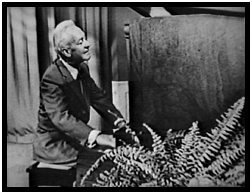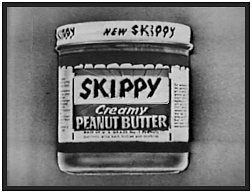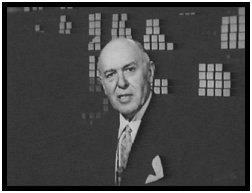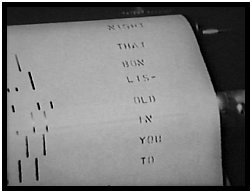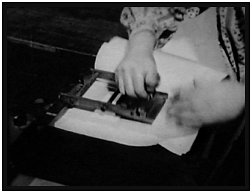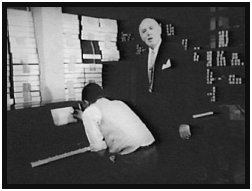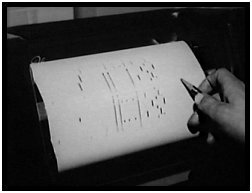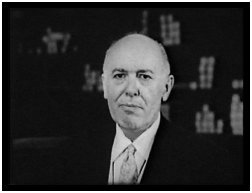| J. Lawrence Cook and Max Kortlander You Asked For It : ABC Television Show Transcribed by Millie Gaddini and Mike Meddings |
![]()
| YOU ASKED FOR IT : ABC TELEVISION SHOW Introduction · Art Baker · You Asked For It Afterword by John Farrell · References · Kudos |
![]()
|
![]()
|
![]()
|
![]()
Art Baker, the “You Asked For It” show host, is “pretending” to play the piano. Note: The opening song roll sounds like ‘Bye Bye Blackbird’ — but it’s not! It might be a J. Lawrence Cook improvisation, to avoid the copyright issue of ‘Bye Bye Blackbird’ appearing on TV. [1] |
![]()
A.B. “Good old player piano. This request comes from Mr. L. M. Broom of Garden Grove, California. He wrote:
“Well, ‘You Asked For It’ Mr. Broom. So let’s head eastward by film, to the Imperial Industrial Company of New York City, and speaking to you will be its President and player piano enthusiast, Mr. Max Kortlander.” |
![]()
M.K. “Yes Art, old faithful, the player piano after all these years is staging a come back. Why? Because people are seeking something different. Families are staying together more at home and also these revolutionary players, such as this Hardman Peck spinet and the player that you are using out in Hollywood, are being manufactured and sold to the public. We also like to feel that our QRS rolls, with their new modern arrangements, are conducive to bringing this comeback to a head.” |
![]()
M.K. “You’ll notice we print the words alongside the notes, so everybody can sing. In our stockroom there are some eighteen-hundred to two-thousand selections. Like old songs that will never die. ‘Missouri Waltz’, ‘In The Shade Of The Old Apple Tree’, ‘I Want A Girl Just Like The Girl’.” |
![]()
M.K. “You’ll all see the latest hits also like, ‘Now’, ‘Rock ’n Roll Waltz’, ‘Poor People Of Paris’. Everyday we scan the trade magazines and double check with our dealers, to see what tunes have hit possibilities. And each month we have a list of popular hits and standards.” |
![]()
M.K. “Many of our tunes have been arranged by that wonderful musician you see in there — J. Lawrence Cook. Lawrence joined us thirty-two years ago as a young piano player. For the past two days Lawrence has been working on an arrangement of ‘Lisbon Antigua’.” Note: I hope no one ever doubted that Lawrence could play the piano. He simply didn’t want to play in public. Robbie Rhodes, who met him in 1971, believes that Max Kortlander would have had a difficult time persuading Lawrence to play live for the interview. [1] Note: In the scene with J. Lawrence Cook at the perforator, as you watch him operate the machine, he plays the notes to be perforated and locks some of the notes down with the stopper mechanism, directly above the keyboard. He then unlocks a few after that step row has been punched. This shows an important part of the process of step perforator recording. In this manner, long extended counter melody perforations and additional notes could easily be made for 4-handed arrangements. [4] |
![]()
M.K. “He’s making what we call a master roll on that piano perforator. Actually, he’s punching the holes for the copies that will soon be on the market.” Note: You hear Lawrence play the C#-diminished chord as the perforator is advancing. This chord is held for at least two beats, so as he played the notes he must have engaged the key latches too. The “cut-away” shot of the master roll does not agree with the sound. I suspect only one movie camera was used for the interview. [1] Note: The master is wider than ordinary rolls and has alignment sprockets down the sides. It is three times longer than the production roll so that overlapping perforations on the roll are kept separate on the master. Almost all piano roll makers used masters of this form, although many were made from scratch using hand punches rather than the sophisticated system shown here. [6] |
![]()
M.K. “Lawrence, in the thirty-three years that you’ve been with this company, how many piano roll arrangements have you made?” J.L.C. “Well, I’d say between fifteen and twenty-thousand Mr. Kortlander.” Note: Lawrence says he made fifteen and twenty-thousand arrangements. This is a vast amount. In other documentation it was assumed he’d been misquoted, yet here he is saying these figures himself. I suppose if you take an average Q.R.S roll, this is an arrangement of the sheet music in itself. [4] |
![]()
M.K. “Lawrence, would you say that making a piano roll arrangement is a specialty?” J.L.C. “It sure is, Mr. Kortlander. It’s very different from anything else. You see, aside from being a musician with a good knowledge of harmony, one must have a very thorough knowledge of the perforating mechanism.” M.K. “Another thing Lawrence. Most people don’t understand how a player piano works.” |
![]()
J.L.C. “Well, I think the best way to explain that Mr. Kortlander, is to say that it is as though a motor from a vacuum cleaner were inside. Through suction, the valves are caused to actuate. Through the force of suction these perforated holes in the roll actuate valves, which in turn, through a linkage system, enables the various keys to be stroked according to the patterns of perforations. All eighty-eight keys are in action.” M.K. “Thanks Lawrence. Now we will be able to hear your work at the end of the tour.” Note: Lawrence rocks on the bench as he positions his foot on the perforator “kick bar.” Then he engages the key latches to hold down the keys of the chord while he kicks the bar to advance the perforator one step at a time. [1] |
![]()
M.K. “Now, Art, let’s go out to the assembly line. This is one of our three master machines in operation. Each of these eighty-eight blocks punches out a different note. Thirty-two copies are being made off of this master at the same time.” Note: The balding man at the paper trimmer is Louis Esposito, who was a perforator operator for many years. [3] |
![]()
M.K. “Each roll is approximately twenty-five feet in length. For a song like this, of three minutes in duration. It takes about seven minutes for a tune to be punched with all the notes.” |
![]()
M.K. “From the master machine, the rolls come over here to this young lady. She stamps the name of the tune, its publisher and its number in our catalog.” Note: Joyce Brite visited Durrell Armstrong in Wichita, Kansas in the hope that he might be able to identify the “blond lady” pictured above. Durrell had worked at QRS/Imperial Industrial Company during the winter of 1957-58. I talked with him yesterday (13 March 2002) and showed him the picture of the mysterious blond lady in the “You Asked For It” film. He thought she might be Margaret Dobbin, who was known to everyone at Imperial as “Dobbie.” [7] |
![]()
M.K. “Then she cuts off the ends of the roll so they’ll fit into the spools. Next, she puts a handle on the end of each to make it easy to attach to the roll on the player piano.” |
![]()
M.K. “Remember earlier I showed you we put the words along side the notes on our rolls. This is where that’s done. This ordinary stencil machine is used first. The words are blocked out on a plate so they can be reproduced many times.” |
![]()
M.K. “The words have now joined the punched notes. Next, we run the rolls on the spools which will fit snug and tight into the player piano. They really zip along nicely, don’t they Art?” |
![]()
M.K. “Down here, by hand, this young lady puts the spools into the boxes. The boxes are stamped correctly. The title of the tune and its number in our catalog. And she sends the boxes down the chute into our shipping room. Then off they go to every State in the Union. To Canada and now even to South Africa.” |
![]()
M.K. “Recognize the tune? Lawrence correcting his first master. Let’s watch him.” Note: The “first master” as Max calls it, would have been run — probably by Cook himself — on a “one-cut” perforator, without interrupting regular production. Many such rolls remain in our archives, bearing Cook’s pencilled notations. [3] |
![]()
M.K. “That sounds fine Lawrence. Thank you.” Note: From a historic perspective, both Lawrence and Max Kortlander just pump the player piano — no twiddling artistically with levers. J. Lawrence Cook’s granddaughter, Lisa Fagg, recalled that when she was young, they would just insert a roll and let it play. This confirms that the QRS product of that period was designed specifically to be suitable for playing in this manner if need be. It was not perforated to demand further intricate manipulation on the part of the pianolist in order to produce a satisfactory performance — unlike say, autograph Metrostyle rolls. This really does show that J. Lawrence Cook had a very thorough knowledge of the capabilities of player pianos and a first-rate understanding of piano music construction and composition. [4] Note: The observation above that neither Lawrence nor Max “twiddle” with the levers when playing the rolls is an important one. Every punched hole in a Cook arrangement is placed exactly where he wanted it to be. It is really a perversion of his work to even touch the tempo lever once the tempo has been set. Through note durations and voicing he gave each arrangement all the color he ever expected it to have, though it’s certainly fun to further “interpret” these aspects by clever pumping, use of soft bass and treble levers and sustain pedal. But the tempo lever really should be left alone. [3] |
![]()
M.K. “You know Art, in dusty attics, cellars and out of the way places, there are possibly five hundred thousand player pianos that need repairing. These are very valuable to many people.” THE END |
![]()
|
![]()
![]()
|
KUDOS |
|||
|
|
||
![]()
![]()
|
|
|
|
|
|
|
|
|
|
|
|
|
|
|
|
|
|
|
|
|
|
|
|
|
|


